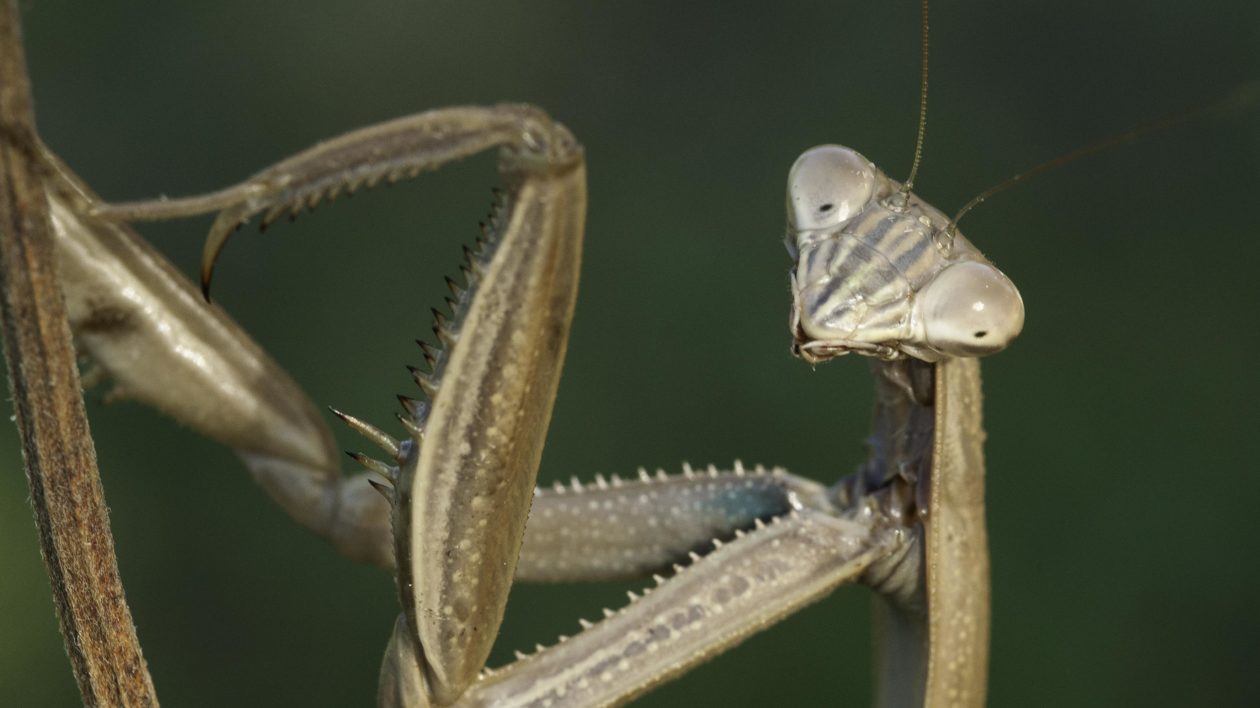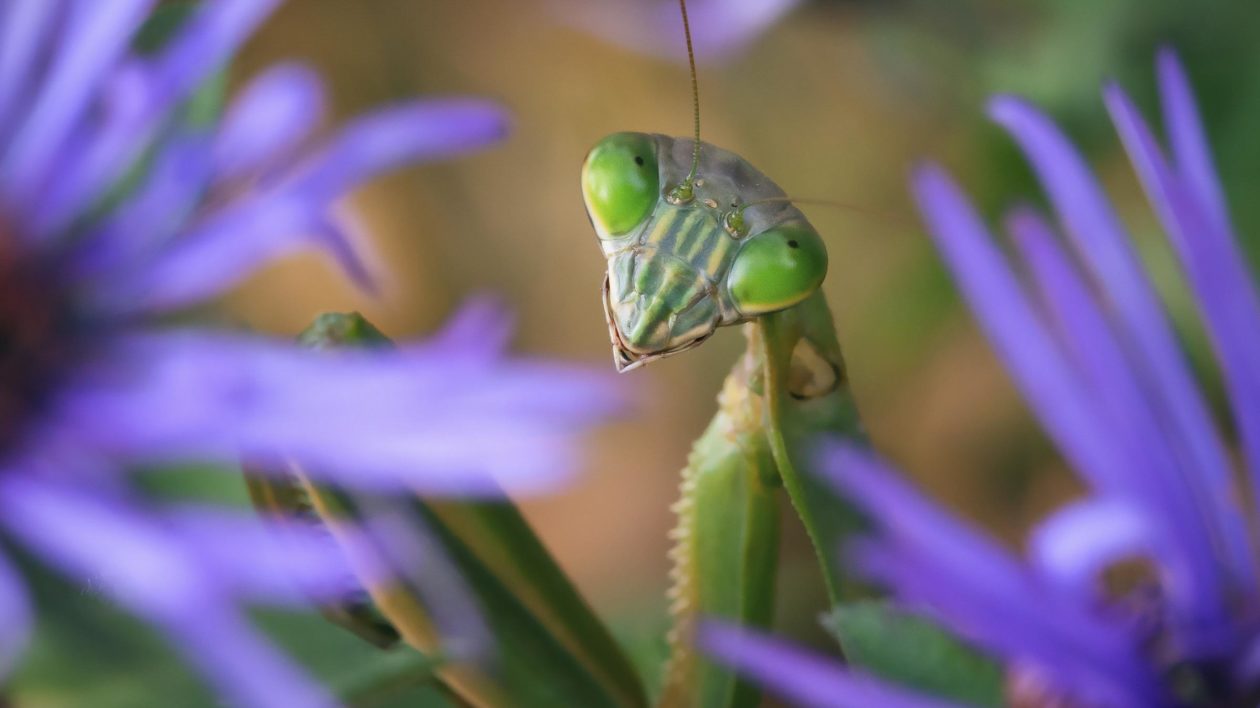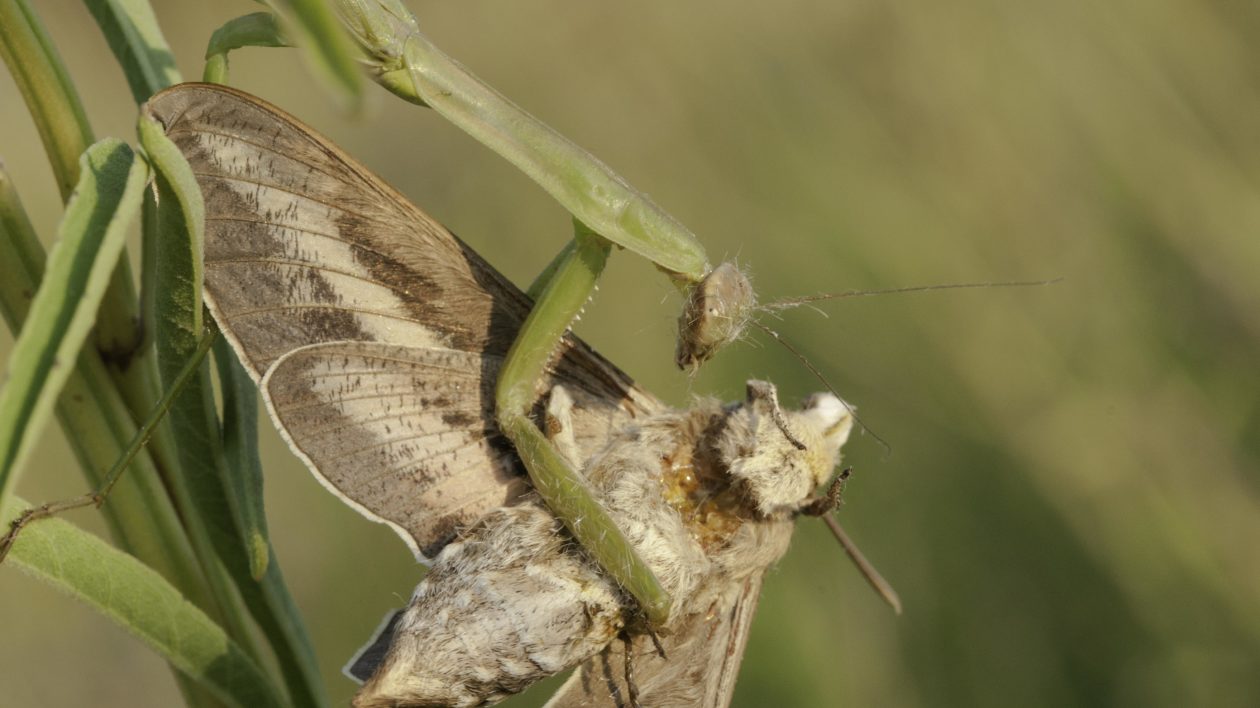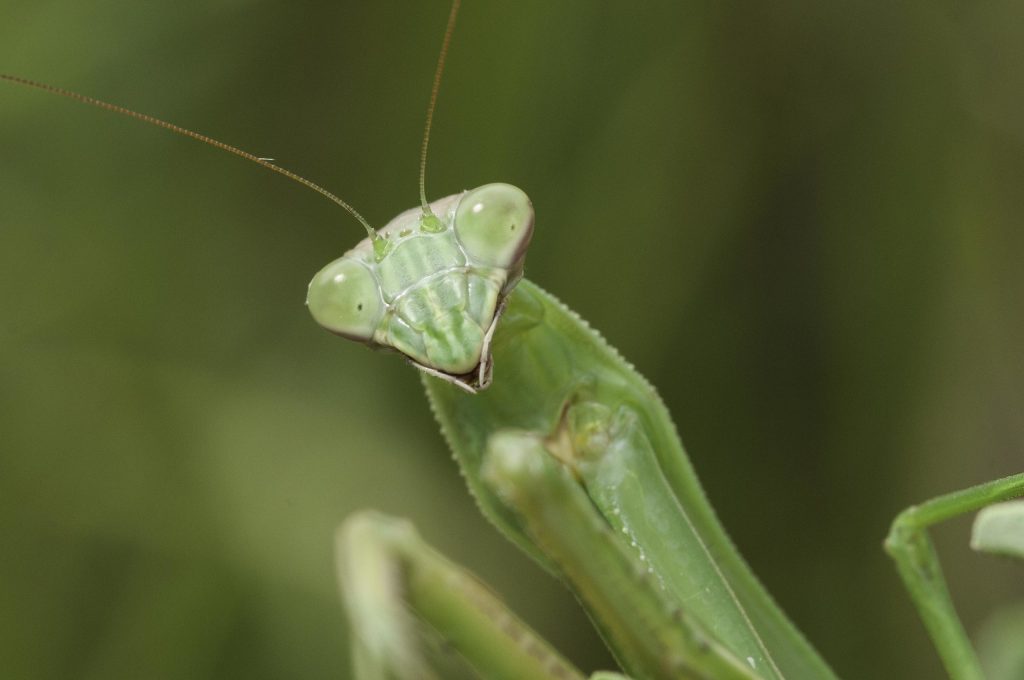My purple coneflowers are crunchy and tipping onto my front porch steps, dropping seeds as they die. It’s time for a trim, but as I bend down to cut the dry stems, I find myself eye-to-eye with a bug in praying stance. Perhaps “preying” would be more accurate.
It’s a praying mantis looking for lunch in an evergreen bush. I pull the pruners, and my fingers, out of reach and watch the insect hunt.
“They’re really good hunters,” says Jenny Read, Vision Science Professor at Newcastle University in England. “I always think about how terrifying it would be to be a cricket when a mantis is around.”
The mantis I’m watching uses one ear and two 3-D eyes to search my yard for food and mates. It’s eager for both in the fall, sometimes at the same time.
There are more than 2,400 species of mantises on earth. They all have long forearms (the better to grab prey), that often are folded when at rest. Many cultures have attributed mythical powers to praying mantis. And it turns out, mantises do have plenty of surprises in store.

Ear
A praying mantis is about six inches long. Much of that length is its long stick-figured body. The bug’s front legs are often folded in pre-strike position, which ironically looks a lot like praying, thus the name.
Get past those commanding pinchers and you’ll find its ear. What it hears with isn’t on its head. A mantis hears with an ear that’s hidden on its chest. And what it hears is beyond our range.
A mantis can hear ultrasonic pulses from bats that use echolocation to locate prey. When a bat targets a mantis for a meal, the mantis knows it by sound collected in its chest-centered ear and it can dive bomb away from a bat’s bite midflight.

Eyes
When you switch the bug’s position from prey to predator, the eyes have it. Praying mantises have two large eyes. That’s not unusual for many insects. What is unusual is placement. Mantis eyes are on the same plane and forward facing on its face, like humans. This is unique in the insect world. Even more unique is the way a mantis uses eye placement to its advantage on a head that swivels 180 degrees.
To study mantis vision compared to human vision, scientists at England’s Newcastle University used beeswax to attach mini 3-D glasses to mantises. One lens filtered for blue, the other for green.
Our brain perceives depth by matching images sent from each eye. It’s called stereo vision. If those images don’t match, we see a blurry object. If those images don’t match in front of a mantis, it doesn’t care as long as there’s movement. Its depth perception is based on movement rather than matching images. That’s why a mantis pinches prey accurately and quickly. It’s ignoring all other factors and zeroing in on movement.
“Mantises don’t have many photoreceptors,” Read says. “It’s better to think of their images as blocky or pixelated rather than blurred.”
A praying mantis sees one thing moving in the crowd rather than the whole crowd moving and it targets that one thing as soon as it moves. Translating this visionary advancement beyond bugs could make simple robots more complex in the way they mechanically work in our world.
For example, the floor sweeper that senses an upcoming wall and knows when to turn so it doesn’t run into the wall. Or how far to extend a robotic arm to pick something up. That’s mechanical depth perception. Studying mantis behavior helps improve that.

The Fishing Mantis
Zeroing in on movement makes a mantis an efficient eater and a deadly lover. From hoppers to birds, this bug eats well and well beyond what we expect.
A researcher in India surprised the world last fall with a fishing mantis. Rajesh Puttaswamaiah documented a mantis on a lily pad in the small pond in his garden. The mantis used the lily pad as its hunting platform while fishing for guppies. It caught and ate nine guppies in five days.
“They’re amazing,” Read says. “They’ve achieved complicated behavior with such a tiny brain.”
Food is a major motivator for mantises in the fall. They’re on the prowl for prey as their one-year life winds down. They’re also looking for mates, sometimes in desperate fashion. Famously, females have been recorded eating males during mating, although recent research indicates that happens less frequently than lore suggests.




I photographed a live preying mantis in my parking lot like one I’ve never seen before. I don’t know if it is an albino or a mutation of a green or red mantis that are frequently seen here in southern California. S/he also had a striking feature of transparent wings. The only part of this creature that had color was the tiny dot of black in each eye. S/he turned to look at me as I drew closer for a photo, warning me to stay back!
Has anyone ever seen such a thing?
they make great pets.I once had one who ate bolonga out of my hand !
When I taught kindergarten we had animals in the classroom. My anole ate crickets so I always had a
terrarium to hold them. Then we found a preying mantis in our front yard so put her in a terrarium and
she went to kindergarten. When she needed lunch I would put her glass house in the middle of the story circle and feed her a cricket. What a show. She would grab the cricket by one leg and eat it like a drumstick. Chomp chomp, head first. Nearby classes heard about her so we would invite them to join us for a mantis show. She produced an egg case and when the nymphs hatched next spring we were thrilled. There seemed to be hundreds, amazingly tiny and beautiful. We couldn’t feed them so they went back home to live in my yard. You can buy all kinds of mantids online. They are fascinating pets.
Loved your article. I have been fascinated by mantis my whole life….found one when I was six and thought it was a foot long. I too have watched them for hours hunting on a plant, blending in, swaying with the breeze as they move stealthily toward their prey. I have actually seen one capture and eat a small lizard. I have had one hang out on mt hummingbird feeder…I never saw her catch one but I did see her attempt to sneak up on them. …they are truly magnificent predators….as a friend of mine said “I find them intimidating, I’m just glad they are not the size of chickens”. lol
I also know they feed on small birds, like hummingbirds. I remove any I find from my feeders. So far I have not found any little Hummer bodies. I am surprised that the first praying mantis just showed up. It is the first week in September.
Did you really just compare the mantle to a machine?
Observing many uses periodically, I one conducted a test about 100 times: As I was wearing wraparound sunglasses, rather looking like a huge conspecific, I had noticed a mangos turn his/her head to note me.
Continuing in that vein, I removed the glasses, finding me actions ignored.
Yet, every time I prefer relatively closely at a mantis, it turned its head. Every time without the wraparound (I did not try flat sunglasses for these) , the mantle did turn to take notice.
Bison, wolves coyotes, cats of all stripes, do that – train their senses upon other animals.
“Vacuums” do not.